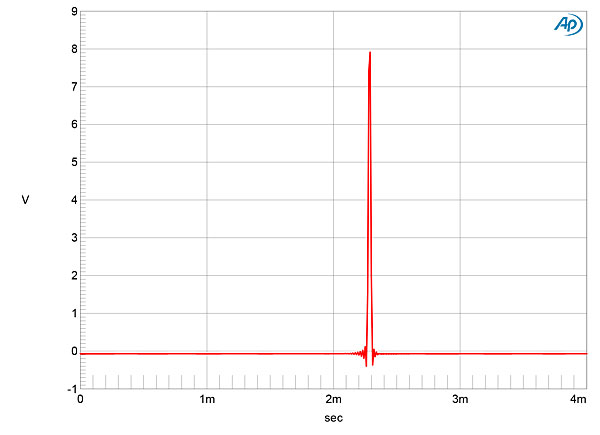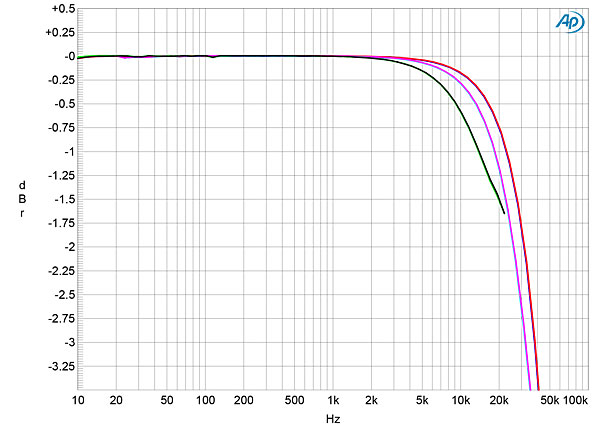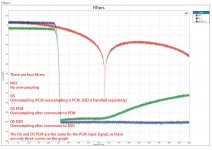If there is no specific cut date, it is open to speculations regarding possible manipulation of results by delaying. It also brings a question why in the middle of collecting results stage there is a call for anynomous results?
The speculation is a good thing in absence of disclosing actual selections. My own guesses were based to a large extent on the dynamics of background sounds that in some cases (like the horns) tried to ignore the oppressive bite.
If there is no specific cut date, it is open to speculations regarding possible manipulation of results by delaying. It also brings a question why in the middle of collecting results stage there is a call for anynomous results?
A specific test cut date is not critical. The number of test reports received is critical. For example, what should we do if we had not received any reports by some arbitrary cut date? We would extend the cut date, is what. So, the number of reports received is governing the test cut date. As Marcel has indicated, our goal is to receive at least six reports. Of course, for higher statistical confidence, I wish would receive fifty reports, but that just isn't going to happen. When Marcel has six or more reports in hand, the test will conclude. I suspect that we are fairly close to that number now.
There should be no concern of delaying for the purpose of manipulating results, since we haven't published a completion date which we've slipped against. So, please put such speculation aside. None of us has a vested interest in manipulating the report data. Again, we are simply waiting for a total of at least six test reports to be submitted. Then Marcel will tabulate and publish the findings. Remain patient.
I just received the sixth report, so the experiment is finished. Time for me to calculate probabilities. I hadn't anticipated it would go so fast in the weekend.
See the attached pdf file for the results.
To all the participants: thanks for participating!
To all the participants: thanks for participating!
Attachments
Last edited:
@MagicBus, it is not uncommon. Most of users of Audio GD (R-1, R-8, R-7, R-28, R-27) DACs which a pure NOS (meaning no processing in NOS mode) prefer 8xOS. Only very low number of people are NOS fanatics, like myself. With other popular brands it is different. Denafrips seems to use linear interpolation to the maximum ladder frequency, the same is expected from a Musician subbrand Pegasus. Holo Audio as Stereophile May test reveal, always deploy digital filtering and filter is set to 20kHz no matter of incoming sample rate, which is only aimed for better measurements. It is why there is no many NOS fans (very expensive brands get no many customers), even in the DIY community NOS is a rare case. However everybody points out that NOS sounds different. Why? It is still not known.
I shared my results with a member who had already submitted results. It turns out that my sound analysis was correct. It is why I am quoting my own post, not a good habit (I admit), but it is the way we can learn something, isn't?
Had been listening in a repeat mode, waiting for a fatigue (remember I am very sensitive to Delta-Sigma distortions) and nothing comes out. Sorry, it doesn't work with my brain.
However maybe I get a clue on the Saint Saens tracks. The first 19 seconds reveals a difference in gong reverbations. When a gong is not hit anymore, it happens at 0:13, focus on a gong reverbations and constant frequency shift. When a string section comes up something happens with a gong...
On the one track frequency of the tone is constantly changing during pulsation. It looks to me the most natural behaviour. Sound is also more pronounced, full body, the strongest reverbations.
On the other track frequency of a tone is becoming less transitional and pulsation becomes more regular.
On the last track frequency shift disappear, there is still pulsation, but it becomes slightly blured with tempo of the music.
@MagicBus, it is not uncommon. Most of users of Audio GD (R-1, R-8, R-7, R-28, R-27) DACs which a pure NOS (meaning no processing in NOS mode) prefer 8xOS. Only very low number of people are NOS fanatics, like myself. With other popular brands it is different. Denafrips seems to use linear interpolation to the maximum ladder frequency, the same is expected from a Musician subbrand Pegasus. Holo Audio as Stereophile May test reveal, always deploy digital filtering and filter is set to 20kHz no matter of incoming sample rate, which is only aimed for better measurements. It is why there is no many NOS fans (very expensive brands get no many customers), even in the DIY community NOS is a rare case. However everybody points out that NOS sounds different. Why? It is still not known.
I don't know if you are participant #5, with the quasi-NOS DAC, but if you are not #5, may I ask why then you listened via OS mode when you prefer NOS, and your DAC apparently is NOS capable?
Ken,
I didn't post results as frankly, you had pi#$%d me off. I deposited my single result to a member who had already submitted his own results. I am using a pure NOS DAC, Audio GD model R2R-11 $350 with upgraded oscilators, currently out of production.
I have to add, I had stronger thought on the Keith Jarrett track, but I own this recording in 24/96k format and I noticed that none of these tracks were similar. It destroyed my confidence, as we were told that one track was original.
I didn't post results as frankly, you had pi#$%d me off. I deposited my single result to a member who had already submitted his own results. I am using a pure NOS DAC, Audio GD model R2R-11 $350 with upgraded oscilators, currently out of production.
I have to add, I had stronger thought on the Keith Jarrett track, but I own this recording in 24/96k format and I noticed that none of these tracks were similar. It destroyed my confidence, as we were told that one track was original.
Last edited:
Ken,
I didn't post results as frankly, you had pi#$%d me off. I deposited my single result to a member who had already submitted his own results. I am using a pure NOS DAC, Audio GD model R2R-11 $350 with upgraded oscilators, currently out of production.
I have to add, I had stronger thought on the Keith Jarrett track, but I own this recording in 24/96 format and I noticed that none of these tracks were similar. It destroyed my confidence, as we were told that one track is original.
I'm totally puzzled. What did I do to p*** you off?
Holo Audio as Stereophile May test reveal, always deploy digital filtering and filter is set to 20kHz no matter of incoming sample rate, which is only aimed for better measurements. It is why there is no many NOS fans (very expensive brands get no many customers), even in the DIY community NOS is a rare case. However everybody points out that NOS sounds different. Why? It is still not known.
Have a look at the NOS filter response, as measured by AudioScienceReview member WolfX-700, and as per May's developer suggestion. I don't know what happened with the Stereophile's measurements, but I can confirm that the NOS filter response with May DAC Level 2 (which is the model and revision that I have) is as per my attachment (as per WolfX-700 measurements).
Attachments
Refering to Audio-pseudo-science-review is a sin. They frequently attempt to hide deficiencies of a sponsor brands like Topping/MSI, now Holo Audio. Look at the first graph, pulse response has pre- and post-ringing.

Fig.1 HoloAudio May, NOS mode, impulse response (one sample at 0dBFS, 44.1kHz sampling, 4ms time window).
This plot shows filtering at 41.1k and higher frequencies. Stereophile test sample is not bandwith limited, where filtering of higher frequencies comes from?

Fig.7 HoloAudio May, NOS mode, frequency response at –12dBFS into 100k ohms with data sampled at: 44.1kHz (left channel green, right gray), 96kHz (left cyan, right magenta), and 192kHz (left blue, right red) (0.5dB/vertical div.).
Source: HoloAudio May (Level 3) D/A processor Measurements | Stereophile.com
They also use digital error randomisation technique which inevitably result in modulating audio frequencies. Users report hearing something like sea-waves correlated with music.

Fig.1 HoloAudio May, NOS mode, impulse response (one sample at 0dBFS, 44.1kHz sampling, 4ms time window).
This plot shows filtering at 41.1k and higher frequencies. Stereophile test sample is not bandwith limited, where filtering of higher frequencies comes from?

Fig.7 HoloAudio May, NOS mode, frequency response at –12dBFS into 100k ohms with data sampled at: 44.1kHz (left channel green, right gray), 96kHz (left cyan, right magenta), and 192kHz (left blue, right red) (0.5dB/vertical div.).
Source: HoloAudio May (Level 3) D/A processor Measurements | Stereophile.com
They also use digital error randomisation technique which inevitably result in modulating audio frequencies. Users report hearing something like sea-waves correlated with music.
Last edited:
The pre- and post-ringing comes from the anti-aliasing filter of the Audio Precision analyser, according to your link. I haven't a clue why they have that much roll-off at sample rates of 96 kHz and above in NOS mode.
Yeah, I read that review and saw the caveat around ringing...
By the way, the Stereophile and Audisciencereview measured filters' plot is almost identical for NOS; they just measured at different white noise levels.
By the way, the Stereophile and Audisciencereview measured filters' plot is almost identical for NOS; they just measured at different white noise levels.
My Echo-Test Results Comments
First, I wish to thank Marcel. He outdid himself with the quality of his final report. Wow!
I also wish to thank all experiment participants. I had expected that the experiment would prove a tedious task for listeners, since you were tasked with ranking levels of subjective preference among three files, for four titles. A total of twelve files! Plus, your assessments were not merely of the sound you heard, but also of how that sound made you feel. Tricky stuff. So, you were given a very difficult challenge, and responded with patience and fortitude. Again, my sincere thanks. 🙂
About the final results. I think that Marcel's report covers everything very thoroughly, especially in terms of his excellent statistical analysis.
I would like to highlight one of his conclusions in particular. Which is, the 5:1 dominance of the experiments conducted via OS DAC (of which I was one, by necessity) to the lone NOS DAC report, that then elevates the suspicion that the filter echo of such DAC's, having their own equiripple OS interpolation-filter, may have increased the detection threshold of the echo phenomena during playback. However, the fact that participant #2 intriguingly submitted perfect rankings for three of the four titles via an OS DAC questions this suspicion. Although, as Marcel states, participant #2's high ranking accuracy could have been by pure chance. Which, only further testing of that participant would prove.
While the experiment results are inconclusive, whether due to having only one NOS DAC utilized, or because the music selections were not the best for revealing the phenomena which we where attempting to detect, or because the number of participants were too small to place statistical confidence in the results (as is usual), or simply because the listeners, in fact, could not detect the phenomena at the levels tested for. 😎
However, as I've indicated previously, our not conclusively finding the precise causal mechanism for why typical OS interpolation-filters seem the culprit for why OS and NOS sound characteristically different, is small intellectual disappointment. What's far more important is that we've seemingly identified pedestrian interpolator implementations as somehow the problem, which then guides us to effective means for mitigating/eliminating that problem. 😀
See the attached pdf file for the results.
To all the participants: thanks for participating!
First, I wish to thank Marcel. He outdid himself with the quality of his final report. Wow!
I also wish to thank all experiment participants. I had expected that the experiment would prove a tedious task for listeners, since you were tasked with ranking levels of subjective preference among three files, for four titles. A total of twelve files! Plus, your assessments were not merely of the sound you heard, but also of how that sound made you feel. Tricky stuff. So, you were given a very difficult challenge, and responded with patience and fortitude. Again, my sincere thanks. 🙂
About the final results. I think that Marcel's report covers everything very thoroughly, especially in terms of his excellent statistical analysis.
I would like to highlight one of his conclusions in particular. Which is, the 5:1 dominance of the experiments conducted via OS DAC (of which I was one, by necessity) to the lone NOS DAC report, that then elevates the suspicion that the filter echo of such DAC's, having their own equiripple OS interpolation-filter, may have increased the detection threshold of the echo phenomena during playback. However, the fact that participant #2 intriguingly submitted perfect rankings for three of the four titles via an OS DAC questions this suspicion. Although, as Marcel states, participant #2's high ranking accuracy could have been by pure chance. Which, only further testing of that participant would prove.
While the experiment results are inconclusive, whether due to having only one NOS DAC utilized, or because the music selections were not the best for revealing the phenomena which we where attempting to detect, or because the number of participants were too small to place statistical confidence in the results (as is usual), or simply because the listeners, in fact, could not detect the phenomena at the levels tested for. 😎
However, as I've indicated previously, our not conclusively finding the precise causal mechanism for why typical OS interpolation-filters seem the culprit for why OS and NOS sound characteristically different, is small intellectual disappointment. What's far more important is that we've seemingly identified pedestrian interpolator implementations as somehow the problem, which then guides us to effective means for mitigating/eliminating that problem. 😀
Last edited:
See the attached pdf file for the results.
To all the participants: thanks for participating!
From the test results report posted in #1107: "The test has produced one significant result, namely the result of participant #2 for hypothesis 0. Either participant #2 was the only one who could hear a clear difference or he made very lucky guesses."
What? As participant #3 I heard mostly clear differences. I don't necessarily support any hypothesis as I was using a Delta-Sigma DAC to hear those differences. The question becomes: If a Delta-Sigma DAC can resolve the differences in files being presented how does one dismiss Delta-Sigma technology seemingly being outrightly inferior?
There doesn't appear anything necessarily wrong with such technology if high frequency artifacts can be prevented from affecting acoustic perceptions. What seems an error in the conclusions of this study is that variant hypothesis(?) contain an underlying conclusion as being a priori true that Delta-Sigma technology is inherently incapable of being better than the rest.
It is what you were told. Attkinson dropped a ball there, perhaps being under pressure. If it is true, then why ringing do not show in other his tests?The pre- and post-ringing comes from the anti-aliasing filter of the Audio Precision analyser, according to your link. I haven't a clue why they have that much roll-off at sample rates of 96 kHz and above in NOS mode.
They perhaps use double resampling, digital filtering with noise shaping during upsampling, then downsampling back to 44.1k. How otherwise they were able to achieve so low SNR figures? They need noise shaping to achieve it.
On the other side JA tried to take your attention to the fig.7, by explaining rolloff characteristic, even estimating a real rolloff numbers. It is how intelligent people communicate each other without throwing a bomb to the dumb masses. There is without doubt digital filtering present at higher 'NOS' sample rates, why wouldn't be the same at CD rates? Pulse response test is consistent with this theory.
- Home
- Source & Line
- Digital Line Level
- What do you think makes NOS sound different?

